The warm summer breeze stirs the trees, but the birds are quiet. Where did they go? This sudden silence worries many nature lovers. But, bird numbers change naturally due to many environmental factors.
Like the seasons, birds move with the changes. Food, weather, predators, diseases, and habitat changes affect their numbers. Knowing these factors helps us understand our local bird friends better.
Key Takeaways
- Temporary bird absences can be a normal part of seasonal and annual population fluctuations.
- Changes in food availability, weather conditions, predator activity, and habitat quality all impact bird presence and movements.
- While overall bird populations are declining, some resident feeder species are actually increasing over the long term.
- Understanding the factors behind temporary bird absences is crucial for addressing long-term conservation needs.
- Citizen science projects are helping to monitor bird populations and provide insights into their changing dynamics.
Fluctuating Food Supplies and Dietary Needs
The number of birds around your neighborhood changes with the food and their dietary needs. The amount of cones, berries, seeds, and insects varies from year to year. This makes birds change how they look for food.
Birds have different dietary needs that change with the seasons. In late summer and early fall, there’s a lot of natural food around. This means birds visit backyard feeders less. But in spring and winter, when there’s less natural food, they come to feeders more often.
- Birds need extra protein in early spring and late summer to grow strong feathers for efficient flight.
- In summer, birds require a varied diet including extra protein and calcium to support breeding and raising chicks.
- During migration seasons in spring and fall, birds need more fat and calories to fuel their journeys.
- In winter, birds seek out rich sources of fat and calories to survive the cold weather.
Knowing about seasonal food changes and bird dietary needs helps you prepare for the changing number of birds at your feeders.
Weather Patterns and Seasonal Changes
As seasons change, birds may move to avoid harsh weather. Droughts, storms, and big temperature changes can harm their homes and food. They move to better places until the weather gets stable.
A long drought can make water and food scarce for birds. Heavy storms can block their usual places to find food. Extreme heat or cold can make birds look for shelter and food in new areas.
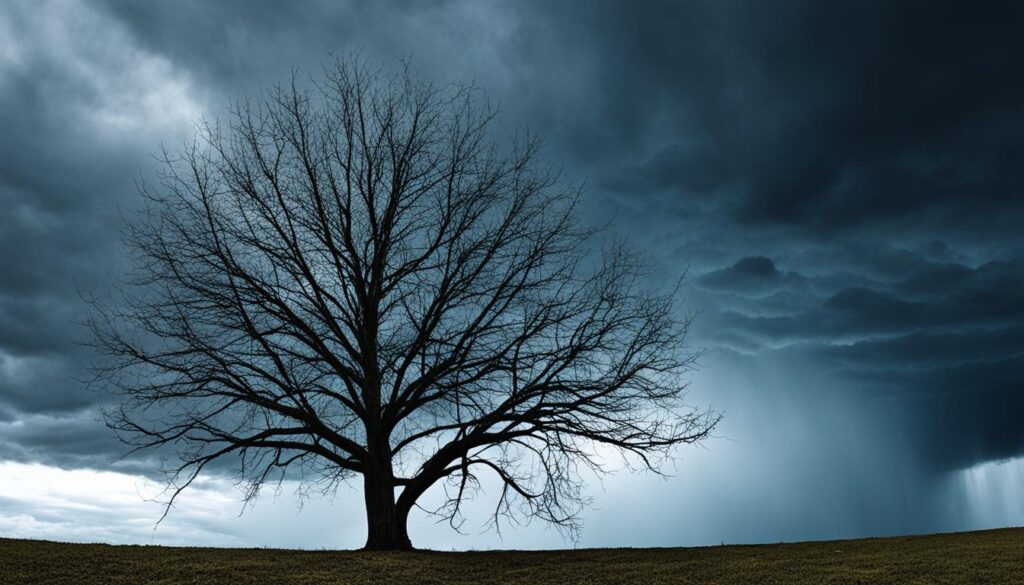
Birds change their paths to survive during these weather changes. This flexibility is key to their migration strategies. It helps them deal with seasonal changes in their world.
“Birds are highly sensitive to changes in their environment, and they often use weather patterns as cues to guide their movements and behaviors.”
Knowing how weather patterns, seasonal changes, and bird behavior are linked helps us understand birds better. It shows how they adapt to environmental challenges.
Predator Populations and Local Impacts
The presence of predators, like hawks, affects local bird populations. Changes in predator populations can lead to shifts in bird numbers. When predators are many, birds might move to safer spots to avoid being caught.
This effect can be seen in a backyard when a hawk settles in. Other backyard predators might stay away until the hawk leaves. Once the hawk is gone, the birds may come back, but their absence is noticeable.
“An estimated five billion pounds of pesticides are manufactured globally each year, with 20% used in the US and Europe, impacting bird populations via various mechanisms such as bioaccumulation, hormonal effects, and weak egg production.”
Keeping a balance between predators and prey is key for a healthy ecosystem. By understanding these dynamics, we can protect the diverse bird populations that are vital to our natural world.
Disease Outbreaks and Population Declines
Feeder birds may not show up due to many reasons like changing food, weather, or predators. But sometimes, disease outbreaks can also be the cause. These outbreaks can greatly reduce the number of some bird species. For example, the West Nile virus hit crows hard in the early 2000s. House Finch eye disease and salmonellosis have also affected feeder birds.
It’s important to watch for and deal with bird diseases to understand and help with population declines. A big outbreak can have huge effects, like the avian flu in the UK since summer 2021. This flu has killed thousands of birds, including seabirds like Gannets, Guillemots, and Kittiwakes. It even reached the Antarctic.
“The recent outbreak of Highly Pathogenic Avian Influenza (HPAI) has devastated UK wild bird populations since Summer 2021, killing tens of thousands of birds in the UK alone.”
It’s hard to see how many small birds die from disease outbreaks. But these outbreaks have a big effect on bird populations. Governments and groups that protect nature are calling for a “One Health” plan to fight avian flu and other bird diseases.
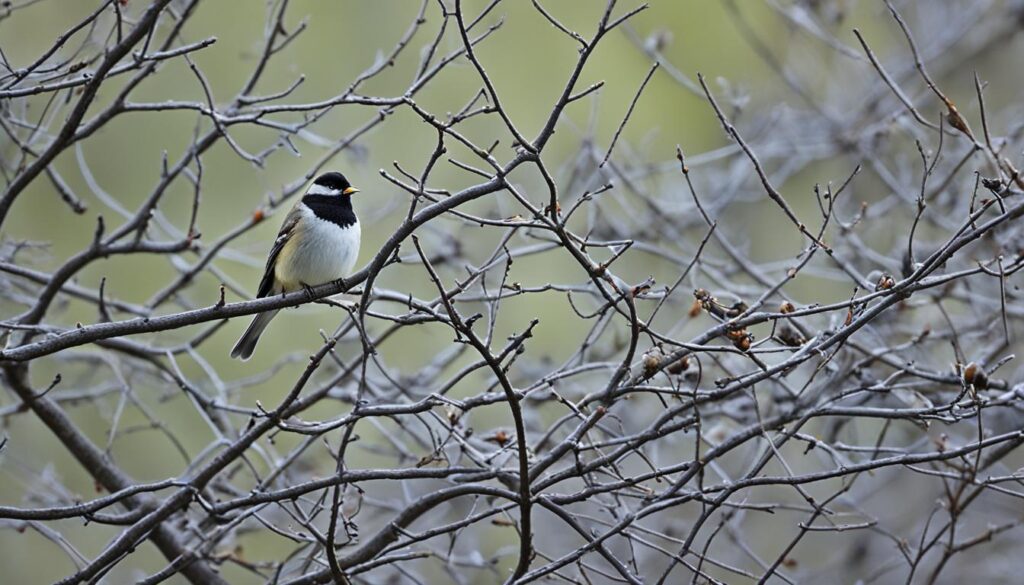
Habitat Changes and Environmental Factors
Habitat loss is a big reason why bird populations are dropping in North America. When we clear forests for tree removal, land development, and housing construction, it changes the environment a lot. These changes affect where birds find food, shelter, and places to nest. This makes it hard for them to live.
Studies show a big drop in North American bird numbers since 1970. Almost 3 billion birds are fewer now. Grassland birds have seen a huge decline of 53%. Common birds like sparrows, blackbirds, and finches make up over 2.5 billion of these losses.
The effects of habitat loss and environmental changes are big. They don’t just mean fewer birds. They also mess with the balance of nature. Birds might have to move to new places, which can cause problems with other animals or finding enough food and shelter.
We need to tackle this problem from many angles. We should work to save and fix natural habitats. We should also try to lessen the effects of land development and tree removal. Supporting conservation efforts is key to protecting birds and their homes. Together, we can keep our skies and lands full of life for the future.
“The decline of birds is a sign that our environment is slowly unraveling. We need to take action now to protect the incredible diversity of life that enriches our world.”
What does it mean when there are no birds around?
Sometimes, you might notice that birds are missing from your yard. You might ask, “Where did all the birds go?” This is a common question, and there are many reasons for it. Fluctuations in bird populations are a natural part of the ecosystem. Weather, food, predators, and seasons all play a role.
One big reason birds might disappear is the fluctuating food supplies and dietary needs they have. As food like insects, seeds, berries, and nuts change, birds move to find better food. This can make them seem like they’ve vanished.
Weather patterns and seasonal changes also affect birds. Droughts, storms, or extreme temperatures make birds look for better places to live. This means they might not be in your yard as much.
- Increased predator populations, such as hawks or cats, can make birds harder to see.
- Disease outbreaks and population declines in certain bird species can cause them to disappear for a while or forever.
- Habitat changes, like tree removal or new buildings, can affect where birds live and how often you see them.
Remember, the absence of birds does not necessarily indicate a problem. It’s normal for bird populations to change over time. Knowing why can help you support the local birds better.
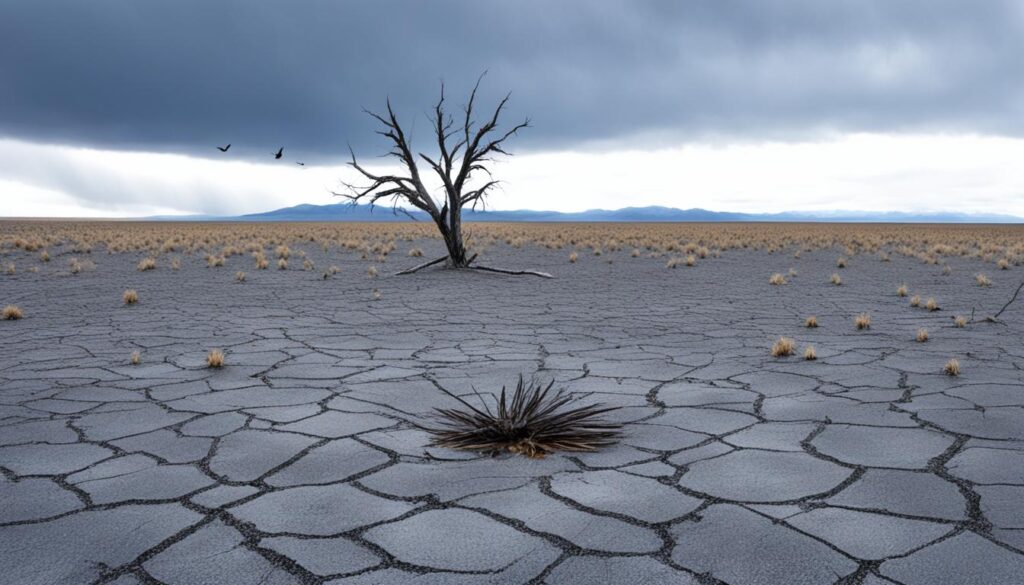
Citizen Science and Bird Monitoring
Scientists are now using citizen science projects to understand bird population trends. These projects, like eBird and NestWatch, let everyday birders share their observations. They report bird sightings and nesting data, which helps scientists track changes in bird numbers and where they live.
Project FeederWatch, run by the Cornell Lab of Ornithology, has been going for over 30 years. It has led to many scientific papers thanks to citizen-gathered data. Other countries have their own bird watching projects, like the UK’s RSPB Big Garden Birdwatch and Australia’s Backyard Bird Count.
It’s important to follow the rules in citizen science projects to get accurate results. For example, in Project FeederWatch, you only report the most birds you see at once. This stops counting the same birds twice and keeps the data right.
About 80% of people in citizen science projects think like scientists. Many citizen scientists use critical thinking and scientific methods. They don’t see themselves as academics but are still making a big impact on science.
“Citizen science projects not only aid in scientific research on migration patterns and environmental impacts but also provide individuals with the opportunity to develop their scientific thinking skills.”
Data from citizen science projects like bird monitoring is key to understanding bird populations. It helps scientists know what affects bird numbers and guides conservation efforts.
Natural Food Abundance and Seasonal Trends
The amount of natural food around your backyard affects how often birds visit. As seasons change, seeds, nuts, berries, and insects become more or less available. This affects how often birds come to your feeders.
When trees or plants produce a lot of food, birds might not need your feeders as much. This is because they have plenty of food in nature. This change in bird behavior happens because of the way food is available throughout the year.
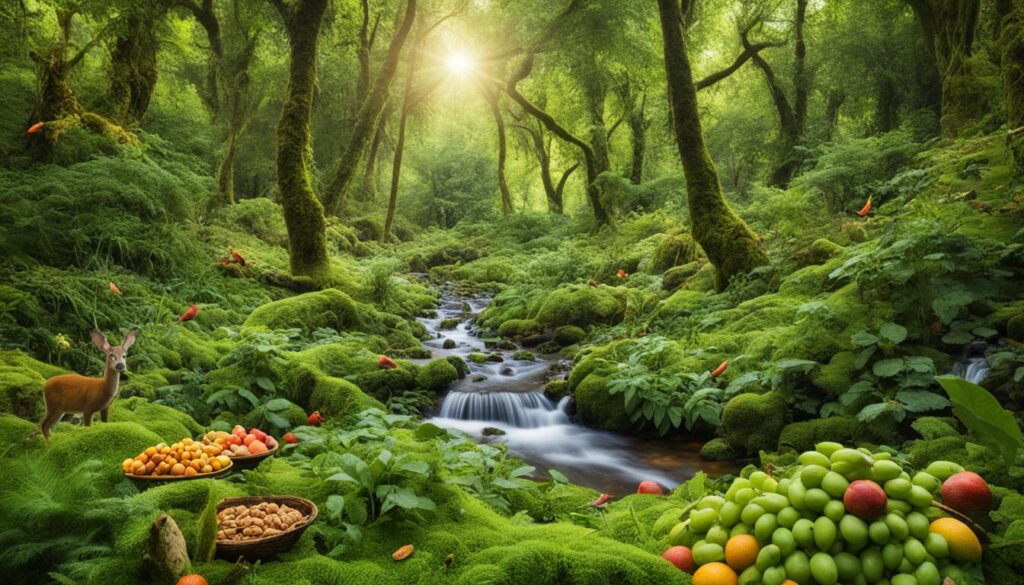
“When there is a surplus of natural foods, birds may visit feeders less frequently, as they can find ample sustenance in their environment.”
Experts say feeding birds is most helpful during extreme weather, when they’re migrating, or in late winter or early spring. But in summer, birds eat more insects and might not need your help as much.
Knowing about seasonal trends and natural food in your area helps you plan better. This way, you can keep your backyard a welcoming place for birds all year round.
Mild Weather and Reduced Energy Needs
When the weather is mild, birds may not need to visit feeders as much. They have plenty of natural food and don’t burn as much energy because of the mild weather. So, they don’t feel the need to eat from feeder visits as much.
Birds can save energy and eat more from what’s naturally available during mild weather. They find plenty of cones, berries, seeds, and insects in their natural habitats. This means they don’t need to visit backyard feeders as often.
“Birds can stand on snow or ice without losing heat due to their feet and legs, which prevent heat loss through cold blood and counter-current circulation.”
Also, birds don’t have to work hard to keep their body temperature stable in mild weather. They can focus on important tasks like finding food and breeding. They don’t need to spend so much time looking for extra food at feeders.
By knowing how mild weather, reduced energy needs, and feeder visits are connected, birders can better understand the birds’ natural behaviors. This helps them appreciate the local bird life more.
Migratory Patterns and Seasonal Movements
The timing of bird migrations greatly affects feeder activity. Some birds, called facultative migrants, can change when they come and go. They stay longer or leave earlier based on food availability. Long-distance migrants might leave early if the weather is right for their journey south.
More than 650 species of North American birds migrate, making up over half of all birds here. These long-distance travelers go from their summer homes in the U.S. and Canada to places in Central and South America. Scientists use tools like geolocators and satellite tracking to study their migratory patterns and seasonal movements. They look for important places where these birds stop and spend the winter.
“The Arctic tern holds the long-distance migration record for birds, traveling between Arctic breeding grounds and the Antarctic each year.”
Where birds live affects their migration paths. Places like Point Pelee in Ontario, the Florida Keys, Point Reyes in California, and Cape May in New Jersey are key spots for bird migration. Sites like eBird Status and Trends offer maps to track migratory bird populations. These maps help us see how their numbers and where they live are changing.
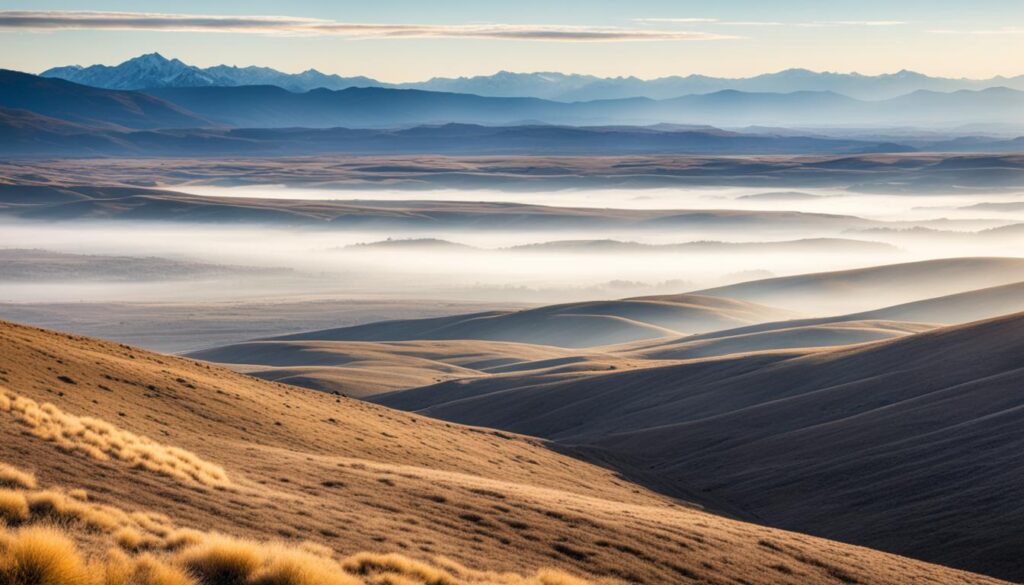
Migration is often driven by the need for food. In the north, longer days in summer mean more time for birds to feed their young. Some birds, like female chaffinches, migrate before males. Swallows flying together can save a lot of energy, up to 12–20%.
Tree Masting Cycles and Seed Production
Many trees, especially oak trees, have unique “masting” cycles. They produce a lot of fruits or seeds in certain years. This means birds have plenty of food, so they visit bird feeders less often. They eat more acorns, nuts, and berries from the trees.
Oak trees are common in North America and have irregular masting cycles. They produce a lot of acorns every 2-5 years. A single giant oak can make nearly ten thousand acorns, feeding many animals like birds, squirrels, mice, and deer.
We don’t fully understand how trees sync their seed production. But, things like spring temperature, summer drought, and spring frost help. These factors affect how the tree’s fruits and seeds grow. When many trees produce seeds at once, it changes the local ecosystem. It affects the populations of animals that eat the seeds.
“Mast years are essential for the regeneration of oak trees and play a crucial role in the intricate checks and balances within ecosystems.”
Not just oak trees, but also maples, hickories, and grasses have their own masting cycles. These events help trees spread their seeds. Animals eat and move the seeds around, helping them grow new trees.
Knowing about tree masting cycles and seed production is key for scientists and those who protect forests. These cycles are important for keeping forests healthy and full of life. They help maintain the balance of nature and support many different species.
Local Observations and Feeder Activity
Watching the birds at your feeders can teach you a lot about the local bird life and how it changes with the seasons. By noting which birds come to your feeders and when, you learn about their natural patterns and what affects their behavior. This helps you understand the local bird population better.
North America has lost one in four birds since 1970, says the 3 Billion Birds campaign. This shows a big drop in bird numbers over time. Backyard birders often see fewer birds at their feeders, which happened in 2017 and 2019 too. This shows that slow feeder activity is not new.
Having lots of natural food, like acorns, beechnuts, and soft seeds from various tree species, can affect how often birds visit your feeders. If there’s plenty of food outside, birds might not come to your feeders as much. Also, bad weather, like a lot of rain followed by mild fall, can change how birds act and use your feeders.
Some birds change their migration plans based on food availability. They might stay longer in one place or move differently if there’s more or less food. And if the weather is mild, birds might not need to eat as much because they don’t lose as many calories keeping warm.

Joining in on projects like FeederWatch can help you learn more about birds. This survey runs from November to April and tracks birds in backyards, nature centers, and community spots across North America. By sharing what you see, you help scientists and conservationists understand bird populations and what affects them in your area.
Conservation Efforts and Biodiversity Loss
The decline of bird populations in North America is a big worry. Bird conservation efforts are key to fight habitat loss, environmental threats, and biodiversity loss. These actions are vital to protect bird species for the future.
Over 70 bird species in the U.S., like the Rufous Hummingbird and Greater Sage-Grouse, have lost half their numbers in 50 years. Grassland birds and shorebirds have seen big declines too. But, there’s hope.
Wetland conservation efforts have helped increase waterfowl and waterbird populations. The American Black Duck is making a comeback. Species like the Mottled Duck and Black Scoter could also recover.
Yet, the situation is still worrying. The U.S. and Canada have lost over 3 billion birds in 50 years. 90 “On Alert” bird species have lost half or more of their breeding populations. This puts them at risk of further decline.
Bird populations face challenges worldwide. Half of the world’s bird species are declining, with many at risk of extinction. Human activities have caused a 60% decline in vertebrates globally since 1970.
As our impact on the environment grows, so does the need for conservation efforts and habitat protection. By tackling the causes of declining bird populations and biodiversity loss, we can help protect our feathered friends and the world they live in.
Conclusion
When birds disappear from an area, it’s often due to many factors. These include changes in food, weather, and predators. Understanding these factors helps us know why birds are gone and how to help them.
Citizen science projects like eBird and NestWatch are key in tracking these changes. They help us see how bird population changes and what affects their homes. This shows us why conservation is so important for birds and nature.
We can make a difference by using sustainable practices and protecting their habitats. By valuing birds and their role in nature, we can help them thrive. Together, we can keep our environments rich in bird life for the future.
FAQ
What does it mean when there are no birds around?
Bird populations change with the seasons and from year to year. This can be due to food availability, weather, predators, diseases, or changes in their homes. Even though many songbirds are declining, some feeder birds are actually increasing over time.
How do fluctuating food supplies and dietary needs impact bird presence?
Birds move around to find food when it’s available. They visit feeders less when they can find plenty of food in nature. Different birds need different foods at different times, so they may not come to feeders as much when they’re eating well.
How do weather patterns and seasonal changes affect bird populations?
Extreme weather can make birds leave their usual places. Droughts, floods, storms, and extreme temperatures can push birds to find better homes. They’ll stay away until the weather gets better.
How do predator populations impact local bird numbers?
Too many predators can hurt bird populations. For example, if there are lots of hawks or cats around, birds might not want to be there. They’ll stay away until the predators leave.
What role do disease outbreaks play in bird population declines?
Diseases can really affect bird numbers. For instance, West Nile virus hit crows hard in the early 2000s. Other diseases like House Finch eye disease and salmonellosis also impact feeder birds. Keeping an eye out for and dealing with diseases is key to understanding why bird numbers change.
How do habitat changes and environmental factors impact bird populations?
Changes in the environment can change where birds live. Things like cutting down trees, building houses, or fires can make it harder for birds to find homes. This can lead to fewer birds in an area and different types of birds showing up.
What is the significance of temporary bird absences in an area?
Birds might not be around for a while for many reasons, like the seasons or big environmental issues. Understanding why they leave is important for protecting them. It helps us figure out how to keep bird populations healthy.
How can citizen science projects help track bird population trends?
Citizen science projects let everyday people help scientists understand bird populations. Programs like eBird and NestWatch ask people to share what they see and learn. This info helps scientists track how bird numbers and where they live are changing.
How do natural food abundance and seasonal trends impact bird activity at feeders?
When there’s a lot of natural food around, birds don’t need to visit feeders as much. This is especially true during seasons when certain trees or plants are producing a lot of food. They can eat what they need from nature.
How do mild weather conditions affect bird visitation to feeders?
When the weather is mild, birds don’t need to work as hard to survive. With plenty of food and comfortable temperatures, they might not rely on feeders as much.
How do migratory patterns and seasonal movements impact bird presence?
The timing of bird migrations can change how often birds visit feeders. Some birds come and go based on the food available. Long-distance migrants might leave earlier than usual if the weather is good for their journey south.
How do tree masting cycles influence bird populations?
Some trees produce a lot of food in certain years, known as masting. When this happens, birds have plenty of natural food. This means they might not need to visit feeders as much.
What can local observations of feeder activity tell us about bird populations?
Watching the birds at feeders can teach us a lot about the local bird population. By noting when birds are there or gone, birders can learn about the natural patterns and what affects them in their area.
How do conservation efforts address the declining bird populations?
Conservation efforts are important to help birds. They focus on protecting their homes, fighting environmental threats, and more. These actions aim to stop the decline of bird populations and protect them for the future.
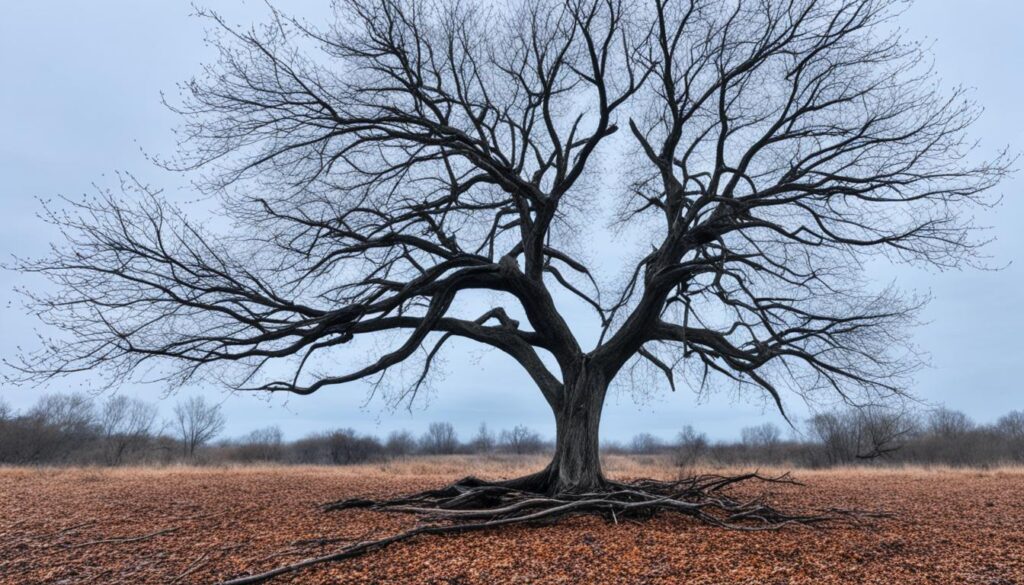

Muchas gracias. ?Como puedo iniciar sesion?
It’s awesome to pay a quick visit this web page and reading the views of all mates on the topic of this paragraph, while I
am also keen of getting familiarity.
Here is my blog :: nordvpn coupons inspiresensation (http://easyurl.cc/nordvpn-coupons-inspiresensation-65357)